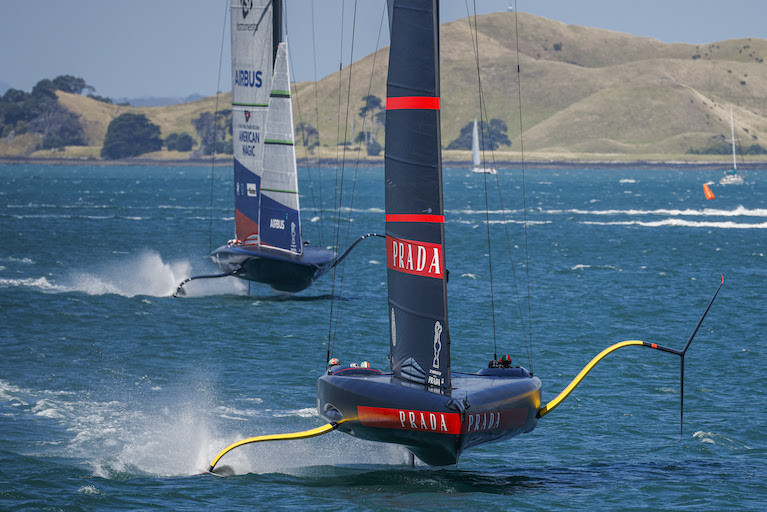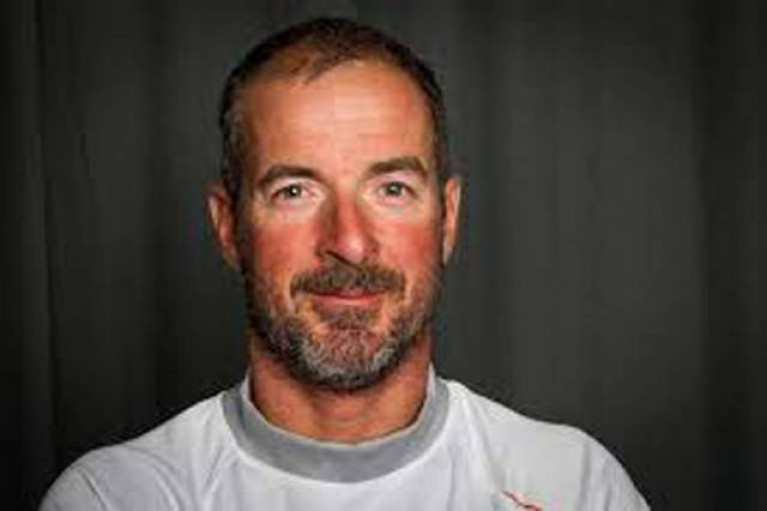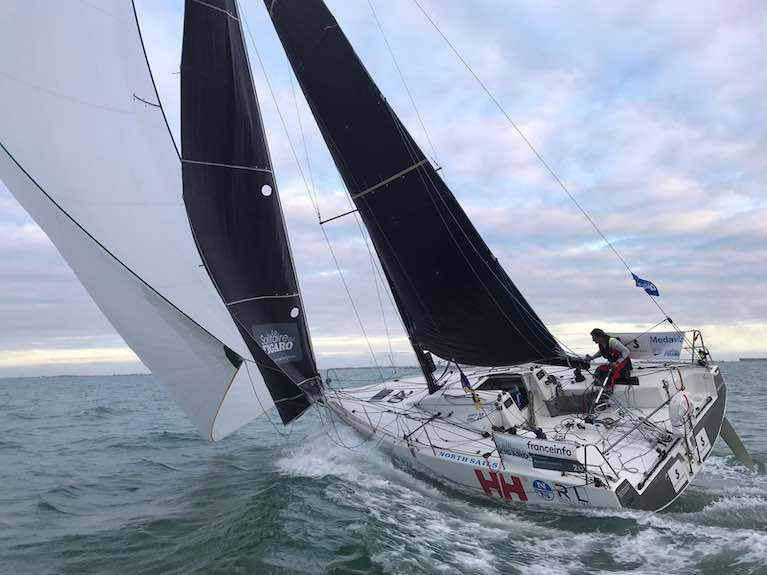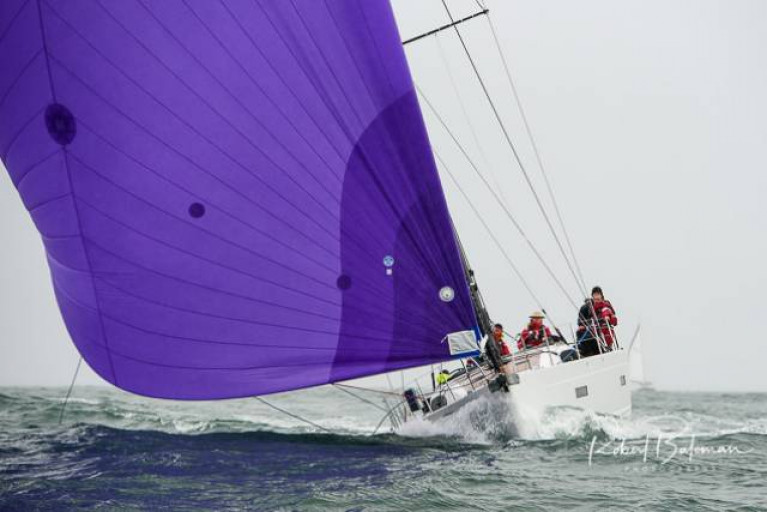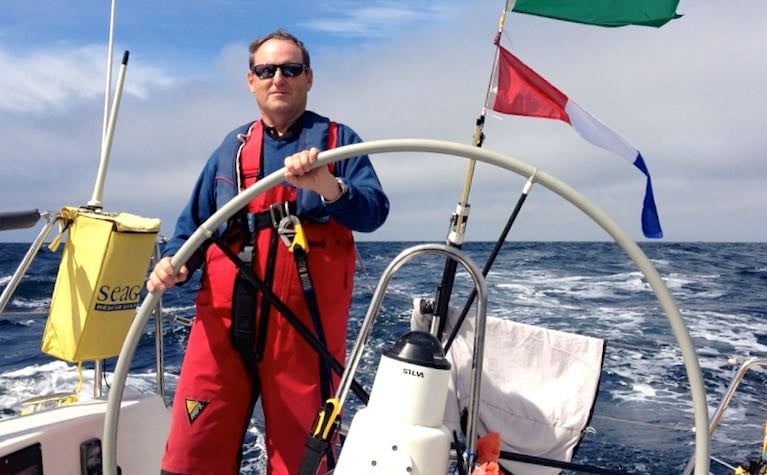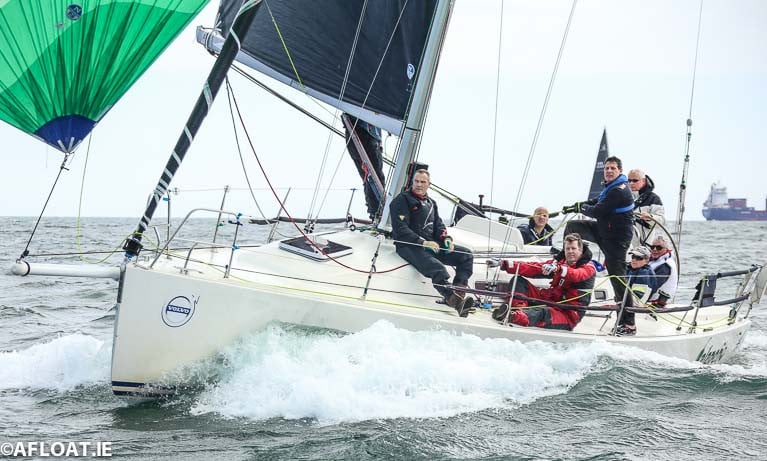Displaying items by tag: National Yacht Club
Internet Sailing Sensations SV Delos Crew Join the National Yacht Club Under 30s for Online Webinar
The grand finale of the first season of the National Yacht Club Speaker Series is at 7.30 pm on Thursday evening (May 4) where the NYC will be joined by YouTube sensations SV Delos!
Delos is a world cruising sailboat home to adventure-seeking souls sailing around the world, following the wind and sun for new and unusual experiences.
With 700k subscribers on YouTube, Delos's Captain Brian joins the Dun Laoghaire Harbour club for an hour of stories and insights; from quitting a desk job and sailing around the world, to reaching YouTube fame.
Zoom Link here

National Yacht Club Plots Expedition Navigation Course With Campbell Field
The National Yacht Club's lively 'Under 30s' section will host an online navigation course on the use of Expedition Navigation software with Kiwi professional yacht navigator Campbell Field.
The aim of the course is to boost the performance of racing navigators.
Course organiser Tom Shanahan says this is a fantastic opportunity for those who are competing in June's Dun Laoghaire to Dingle Race and wish to gain an edge!
Campbell Field has raced and navigated yachts in all corners of the world. From Superyacht regattas in the Caribbean to Whitbread/Volvo Ocean Race and 2-handed 40 footers across the Southern Ocean.
Shanahan says the course will be useful for those who are looking at upgrading their boats and want to have an insight into Expedition, "The aim of this course is to educate crew to a competent level so they may interpret and use Expedition, " he says.
Expedition, says Shanahan, is a very powerful software that is the aid of choice for most navigators inshore and offshore.
There is no prior experience needed to take the course - everything will be explained in full.
- Date: Saturday 13th March
- Start time: 10:30
- Webinar Length: 2 hrs
- Price: approx €18
Signup here
National Yacht Club Circumnavigator Conor O'Regan Talks on Planning a Round the World Voyage; Tonight on Zoom!
The National Yacht Club U25/U30 Speaker Series continues this evening with the Dun Laoghaire Harbour club's very own Vice-Commodore Conor O'Regan who circumnavigated the globe in his 38-foot yacht 'Pamina'.
O'Regan will walk attendees through everything from preparation and planning for such a voyage to include transiting the Panama Canal and Pacific Island adventures.
O'Regan's Pamina usually swings on an NYC mooring off the East Pier in his home port.
 NYC Vice Commodore, Conor O’Regan, and Henrietta on their Pacific Island adventure
NYC Vice Commodore, Conor O’Regan, and Henrietta on their Pacific Island adventure
The talk starts at 7.30 pm. All welcome. Zoom Link here
National Yacht Club 'Lift in' on Schedule for April 9th as Commodore Issues 'Cautious Note of a Return to the Water' at Dun Laoghaire Harbour
National Yacht Club Commodore Martin McCarthy has issued a cautious note of return to the water and summer sailing plans in Dun Laoghaire Harbour.
Subject to Government restrictions that see Level 5 currently extended to April 5th, McCarthy told members in an update that the East Pier Club is planning for the annual lift-in of cruisers to take place as scheduled on April 9th.
The day-long operation marks a traditional start to the Dublin Bay summer sailing season in just 45 days time.
As single-handed sail training is permitted, McCarthy also expects there will be more members back on the NYC platform as the weather improves.
The NYC's neighbours at the Royal St. George Yacht Club is also expected to 'lift in' its fleet a day later on April 10th, a month before that club welcomes the 2021 IODAI Optimist dinghy trials to its forecourt.
The National Yacht Club is staging some of this year's key events this summer, subject to restrictions, including June's Volvo Dun Laoghaire to Dingle Race, July's Volvo Dun Laoghaire Regattas, August's ILCA Laser 4.7 Youth World Championships as well as September's ICRA National Championships.
National Yacht Club Hosts Cxema Pico & Nin O'Leary for Online Talks
For the penultimate weeks of the National Yacht Club the U25/U30 Speaker Series, the committee has organised a doubleheader of online talks.
Tonight, 16th February, the Dun Laoghaire East Pier Club dives back into the world of America's Cup. Umpire Cxema Pico will be online to discuss rules and racing scenarios from The Prada Cup finals.
Nin O'Leary
On Friday, 19th February, Nin O'Leary joins for a chat through his career and to give us an insight into sailmaking, design and the future of sail technology. O'Leary is one of Ireland's most experienced big boat sailors having raced everything from IMOCA '60s to Star one-designs as well as superyachts.
Talks start at 7.30 each evening.
Zoom Link here
Damian Foxall Online Tonight at National Yacht Club
The National Yacht Club's Will Byrne will host tonight's talk with Irish offshore star Damian Foxall online via Zoom.
As Afloat previously reported, the U25/U30 section at the Dun Laoghaire Harbour club has put together a list of guests for a five-week speaker series and tonight at 7.30 pm, the Country Kerry racer will speak on his offshore racing achievements in the world-girdling Ocean Race and Barcelona Race plus his views on the marine environment after his recent expedition to Antarctica.
The talks are open to everyone who is interested in sailing.
Zoom link is here
National Yacht Club U25 Speaker Series Features Some of Ireland's Offshore Sailing Greats
The National Yacht Club's U25/U30 section at Dun Laoghaire Harbour has curated quite the list of guests for a five-week speaker series starting this Thursday, 26th January at 7.30 pm. The talks are open to everyone who is interested in sailing.
This week, Pam Lee and Kenny Rumball will walk through their two-handed offshore adventures and give a look into the future as they prepare for a Paris 2024 Olympic campaign in the proposed mixed offshore keelboat discipline.
 National Yacht Club 2021 U25 speaker Series calendar. The talks start each Thursday at 7.30 pm
National Yacht Club 2021 U25 speaker Series calendar. The talks start each Thursday at 7.30 pm
The series will continue with talks from a wide range of guests including the world-famous offshore sailor Damian Foxall, Cork Harbour's Nin O'Leary, round the world cruiser Conor O'Regan and Will Byrne and Cian Mollen who will give a rundown of the current Americas Cup.
 Nicholas 'Nin' O'Leary will talk about life as a professional sailor on February 18th
Nicholas 'Nin' O'Leary will talk about life as a professional sailor on February 18th
Zoom Link (will work for all the talks) here.
National Yacht Club's Volvo Dun Laoghaire-Dingle Race 2021 Should Get Us Going Again
It's getting to be like a game of skittles in the planned lineup of high-profile 2021 events which everybody - way back in the dark depths of earlier pandemic lockdowns – thought would surely come to pass in the remote sunlit heights of what was then the distant future of supposedly plague-free 2021.
The skittles that have fallen this week have included the RORC Caribbean 600 scheduled for Monday, February 22nd off English Harbour, Antigua, and the 565-mile Rolex China Sea Race, which wasn't due to start until March 31st from the Royal Hong Kong YC. They're both gone, and gone so completely we've been given the 2022 dates already as consolation prizes.
 Start of the small class in the RORC Caribbean 600 in February 2020. The 2021 Race, scheduled for February 22nd, was cancelled this week.
Start of the small class in the RORC Caribbean 600 in February 2020. The 2021 Race, scheduled for February 22nd, was cancelled this week.
So which skittles will still be standing as the pandemic moves away with glacial speed, and we begin to feel reassured that the vaccines are having a real effect? At the moment, with one viral surge piling on another like a feast-day down at Aileen's breaker off the Cliffs of Moher even as vax distribution tries to find the best way forward, the resumption of something remotely approaching normal life is anyone's guess.
Thus we might as well look back at our slightly chirpy preview of the possibilities for 2021, which we published here a mere four weeks ago, just as the ludicrous Christmas socialising was starting to weave its hyper-infectious wicked web. While very reasonably suggesting that the best plan was to keep planning - as followed and demonstrated in various extreme situations by General Dwight D Eisenhower - we did have enough savvy to suggest that though some events were already posted as preceding it, the National YC's 280-mile Volvo Dun Laoghaire to Dingle Race on June 9th had the whiff of reality about it as an internationally-recognised classic that provided the ingredients for getting an inevitably still-limited season properly underway.
 Ian Hickey's 38ft Cavatina from Cork – twice winner of the Round Ireland race – is on the entry list for the D2D in June
Ian Hickey's 38ft Cavatina from Cork – twice winner of the Round Ireland race – is on the entry list for the D2D in June
It seems a lot of other people thought the same way, for no sooner was the entry list opened recently than they were into double figures with boats of serious provenance – the largest of them Conor Doyle's xP50 Freya from Kinsale – and as of yesterday (Friday) the listing had gone up to 32, making it look as though Organising Committee Chairman Adam Winkelmann and his team will indeed have to invoke their fifty boat limit.
It's all good news, and we'll look at these early entries in more detail in a moment. But though there is this glimmer of light in the distance on June 9th (with Howth's Lambay Race a nice little possible programme starter on Saturday, June 5th), we're looking at things that might just happen nearly five months away, which seems like forever. But fortunately, any internationally-minded sailing fan will find happenings of interest in the meantime.
As it is, through the winter some events have taken place, though in very shrunken-numbers versions. However, enough boats took part in the ARC 2020 to St Lucia before Christmas to note that the most interesting class winner was the 59ft classic 1936 German yawl Peter von Seestermuhe (formerly Peter von Danzig). She was designed by Henry Gruber, who served his time in the Sparkman & Stephens office in New York in the early 1930s, and then returned for a successful if brief individual design career in his native Germany, a career which was going fine until World War II got in the way.
 The classic 1936 Henry Gruber-designed yawl Peter von Seestermuhe crosses the line in St Lucia in December to win her class in the ARC 2020.
The classic 1936 Henry Gruber-designed yawl Peter von Seestermuhe crosses the line in St Lucia in December to win her class in the ARC 2020.
Gruber's extremely elegant yacht design oeuvre culminated in the handsome 88ft Nordwind (she's still going strong) for the Kriegsmarine – the German Navy - in 1939, when she took line honours in the Fastnet Race. In doing so, she toppled the 70ft Hallowe'en's course record which had stood since 1926. And yes, that's the classic Fife-designed-and-built Hallowe'en now owned by an Irish syndicate. At the prizegiving in Plymouth in 1939, Nordwind's German navy crew took everyone's breath away by turning up in their very smart Hugo Boss-designed dress uniforms, adding to the effect with a cascade of Heil Hitler salutes all round as they collected their trophies.
We can only hope that when the likewise under-the-radar RORC Transatlantic Race - currently underway from Lanzarote in the Canaries to Grenada in the Caribbean after being postponed from December – gets to the finish, and then on ashore to the mono-hull line honours winning crew collecting their trophies, that we'll see completely informal air-punching salutes. For it's possible that the first mono-hull across will be that gallant old warhorse, the Irish-Chinese Volvo 70 Green Dragon, a veteran of the 2008-2009 Volvo Round the World Race.
 The old dog for the long road – the 2008 Irish Volvo World race entry Green Dragon – seen here at 30 knots – is currently vying for line honours in the RORC Transatlantic Race from the Canaries to Grenada.
The old dog for the long road – the 2008 Irish Volvo World race entry Green Dragon – seen here at 30 knots – is currently vying for line honours in the RORC Transatlantic Race from the Canaries to Grenada.
Having graced the seafront at Salthill post-world-race for a while, the somewhat overweight Dragon was eventually sold to Austrian Johannes Schwarz in 2015 "for rather less than her building cost". As a result, the new owner got a bulletproof boat which has since given many people a lot of good sport afloat and much fun ashore.
So although Green Dragon's lead on the water is being challenged by two of the latest French Class 40s which feature the very fast downwind scow hull shape which was successfully pioneered some time ago by Ian Lipinsky in his Mini-transat Proto Griffon, let's hear it for the old Dragon hanging in there to give everyone the vicarious satisfaction of a line honours win.
Meanwhile, the Vendee Globe leading group has closed up off the east coast of Brazil to open up the possible final results, and while they may be talking in terms of a finish within a dozen days, the reality is that they still haven't even re-crossed the Equator yet, and the North Atlantic between there and the finish in the Bay of Biscay can be one very obtuse bit of wind and water as January morphs into February.
 A boat transformed. While other America's Cup teams in New Zealand took a Christmas break, Ineos Britannia's technical staff worked night and day to transform the boat into a real contender for this week's resumption of racing.
A boat transformed. While other America's Cup teams in New Zealand took a Christmas break, Ineos Britannia's technical staff worked night and day to transform the boat into a real contender for this week's resumption of racing.
For complementary entertainment, the America's Cup in New Zealand has suddenly leapt to life with Ben Ainslie's Ineos Britannia a boat transformed this week into a seeming potential winner. Her technical team had worked all hours on mods since the pre-Christmas series, when she had been usually found in the crabgrass. This new look has resulted in much excitement afloat, but it's as nothing compared to the kerfuffle in the back offices of the bookmakers of Auckland, where they'd been rating Ineos Britannia as the rank outsider in the betting until Friday of this week.
By the time the America's Cup is drawing to its conclusion in March, the pandemic picture will be much clearer, it's possible other events of a more pop-up nature will have emerged, and hopefully, we may be looking at some controlled sailing in May, with the arrival of June seeing a more positive scene afloat.
Thus a short and sweet Lambay Race on June 5th and a long and lovely Dingle Race on June 9th would be a neat combination, as both involve a real homage to the coasts of Ireland. Their basic course concepts are as simple as you can get, and yet as both are essentially coastal events in one jurisdiction, regulations are easily defined and complied with.
 Two is better than one. For the D2D, Andrew Hall of Pwllheli has entered both his J/125 Jack Knife (above)……….
Two is better than one. For the D2D, Andrew Hall of Pwllheli has entered both his J/125 Jack Knife (above)……….
 …… and the internationally successful Lombard 45 Pata Negra
…… and the internationally successful Lombard 45 Pata Negra
That said, the list of entries for Dingle as seen here shows there's already an international element, none more so than through Andrew Hall of Pwllheli, who has done a Matt Allen in having two entries – his own J/125 Jack Knife, and the chartered Lombard 45 Pata Negra which has provided several Irish crews with high-grade international success in recent years.
Even as it stands with 18 places still available, it's a formidable list with most of the main Irish sailing centres well represented, and a truly formidable line-up of hotshot boats gearing themselves up to deny Paul O'Higgins JPK 10.80 Rockabill (RIYC) the satisfaction of making it three in a row.
 The current benchmark performer – Nieulargo finishing at Roche's Point to win the 2020 Fastnet 450. Photo: Robert Bateman
The current benchmark performer – Nieulargo finishing at Roche's Point to win the 2020 Fastnet 450. Photo: Robert Bateman
For although Rockabill showed she'd lost none of her edge through retaining the admittedly restricted ISORA Championship in 2020, she has yet to race the Murphy family of Kinsale with their all-conquering Grand Soleil Nieulargo in her current very competitive form. Nieulargo was a competitor in the previous D2D in 2019, but the Nieulargo of 2020 and today has upped her game and is a very different machine.
Extra interest is added with a two-handed division in which Cian McCarthy's Sunfast 3300 from Kinsale is already entered, and Dingle interest is stepped up not only with added support at the finish port but also with one of the early entries in the form of Kenneth Cunnane's Dingle-based Swan 46 Mynx.
Cinnamon Girl from Kinsale has entered for the two-Handed Division:
Adam Winkelmann is particularly pleased with the very positive attitude towards the race down in Kerry:
"The ongoing support by Volvo and Billy Naughton Cars underlines the value of the partnership of the event over many years," he says. "The Dingle Skellig Hotel also continue as accommodation partner and long-term sponsor, and we are delighted to work with them again in 2021.
 Billy Naughton of Volvo agents Billy Naughton Cars presenting the second overall prize to Aileen Kelleher, a crew member of the J/122 Aurelia (RStGYC) at the prizegiving in the Dingle Skellig Hotel after 2019's race
Billy Naughton of Volvo agents Billy Naughton Cars presenting the second overall prize to Aileen Kelleher, a crew member of the J/122 Aurelia (RStGYC) at the prizegiving in the Dingle Skellig Hotel after 2019's race
While we are optimistic for the race itself in terms of on the water activity, we will have to wait and see what the Covid-19 situation allows in terms of on-shore activity around the race at the time. As always, it is the participants and public health that will take priority in terms of gatherings or prizegiving.
We also continue with great support from ISORA and DBSC as on-the-water partners. The timing of the 2021 race is designed to accommodate boats participating in Sovereigns Week (23 – 26 June) in Kinsale, and of course with the Volvo Dun Laoghaire Regatta (2-4 July One -Design and 9 -11 July Cruisers)
The Notice of Race is now available to download at www.d2drace.ie and entries can be made online via the website. Accommodation can be reserved directly with the Dingle Skellig Hotel www.dingleskellig.com"
Peter Ryan of the National Yacht Club is "Sailor of the Month (Services to Sailing)" for December
Peter Ryan of Dun Laoghaire is a dedicated sailing enthusiast – particularly for offshore racing – whose affable exterior camouflages the fact that his brain is busily whirring with ideas for improving the sport. Thus when the challenges of pandemic shutdown arose, he grasped the opportunities provided by being Chairman of the Irish Sea Offshore Racing Association, and having access to a generously donated consignment of Yellowbrick trackers, to set about devising a programme which would comply with regulations while still providing good sport.
It may not have been offshore racing as we know it, as it lacked the post-race parties previously thought indispensable. But it was a proper coastal racing programme nevertheless, with an overall champion (Paul O'Higgins' JPK 10.80 Rockabill VI, RIYC) by the final race in September, while the general ISORA contribution to the legitimate continuation of the sport was also seen in the loan of the Yellowbricks for the excellent Fastnet 450 race in August, and the hugely successful Round Ireland Two-Handed Speed Challenge by Pam Lee of Greystones and Cat Hunt with the Figaro 3 Iarracht Maigeanta in October.
But then Peter Ryan is no stranger to success – he was Commodore of the National Yacht Club in 2011 when it became the Mitsubishi Motors Sailing Club of the Year.
 Responsibility worn lightly - Peter Ryan as Commodore of the National Yacht Club in 2011.
Responsibility worn lightly - Peter Ryan as Commodore of the National Yacht Club in 2011.
National Yacht Club Salutes Its Winning DBSC Boats
National Yacht Club members were on award-winning boats in the Dublin Bay Sailing Club's list of prizewinners for the cut-short 2020 summer season.
In Cruisers One IRC racing, Paul Barrington's J109 Jalapeno was the Saturday race champion while John O’Gorman's Sunfast 3600 Hot Cookie was the Thursday ECHO Champion.
In DBSC's premier awards, the National Yacht Club Ruffian Alias (Woods, Moore, Miller, McCarthy) won the Weir Cup for the Best yacht frequently participated and Rian Geraghty-McDonnell was the top DBSC dinghy performer.
The results drew praise from NYC Commodore Martin McCarthy, "It is fantastic how many NYC members were on award-winning boats" he told Afloat.
Declan Curtin and his crew on the J80, Jester were winners in the Mixed Sportsboats class. They won The Thursday’s Sportsboat Cup and the Overall Thursday Cup.
 John Power and Michael Leahy's Beneteau 31.7 Levante was the Saturday Scratch winner
John Power and Michael Leahy's Beneteau 31.7 Levante was the Saturday Scratch winner
The National Yacht Club's Ignus Caput sailed by David Mulvin and Ronan Beirne were the winners of the Fifty Something Cup for Tuesday Racing in the Flying Fifteen class. The pair also won the Brian S Ryan Trophy for Saturday Racing. The Flying Fifteen Gun Trophy went to Chris Doorly's Frequent Flyer for Thursday Racing
In the Laser Radials, Rian Geraghty McDonnell was the Sailcraft Tray Trophy winner for Tuesdays and Saturday's combined and Conor Gorman won Saturdays. Luke Turvey won both Tuesdays and Saturdays in the 4.7 class.
A full list of prizewinners is here.
NYC DBSC 2020 AWARDS
|
Cruiser 0 Knox-Gore Bowl |
Thursdays Echo Racing |
Hot Cookie |
John O’Gorman |
|
Cruiser 1 Weir Cup Brendan Ebrill Memorial Cup Dr Alf Delany Cup |
Saturdays IRC Racing Best yacht frequently participated Best Dinghy for the season |
Jalapeno Alias Laser Radial |
Paul Barrington Woods, Moore, Miller, McCarthy Geraghty, McDonnell |
|
Beneteau 31.7 Feanor Trophy Horrigan Cup Arandora Trophy Cut Glass Tumbler Long John Silver Cup British Airways Trophy J. Lamont Trophy John Donnelly Perpetual Cup |
Thursday Racing Scratch Thursday Racing Echo Saturday Racing Scratch Tuesday Racing Scratch Saturday Racing Echo Saturday Racing Thur & Sat combined Tuesday Racing |
Prospect Kernach Levante Levante Attitude Bandit Bandit Bandit |
Chris Johnston Eoin O’Driscoll Power, Leahy Power, Leahy Trina Miller Kirwan, Cullen, Brown Kirwan, Cullen, Brown Kirwan, Cullen, Brown |
|
Flying 15’s Fifty Something Cup Brian S Ryan Trophy Flying Fifteen Gun Blake Cup |
Tuesday Racing Saturday Racing Thursday Racing Midweek Handicap Racing |
Ignus Caput Ignus Caput Frequent Flyer Rodrigues |
Mulvin, Beirne Mulvin, Beirne Chris Doorly Ken Dumpleton |
|
PY Single Handed Windmill Cup |
Tuesdays Overall |
RS Aero Orion 328 |
Noel Butler |
|
Lasers Sailcraft Tray Trophy Cut Glass Tumbler Cut Glass Tumbler Cut Glass Tumbler |
Tues & Sat Std Saturdays Overall Radial Tuesdays Overall 4.7 Saturdays Overall 4.7 |
216894 207800 194650 194650 |
Geraghty, McDonnell Conor Gorman Luke Turvey Luke Turvey |


























